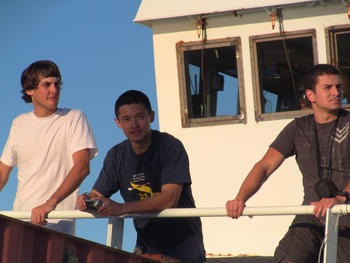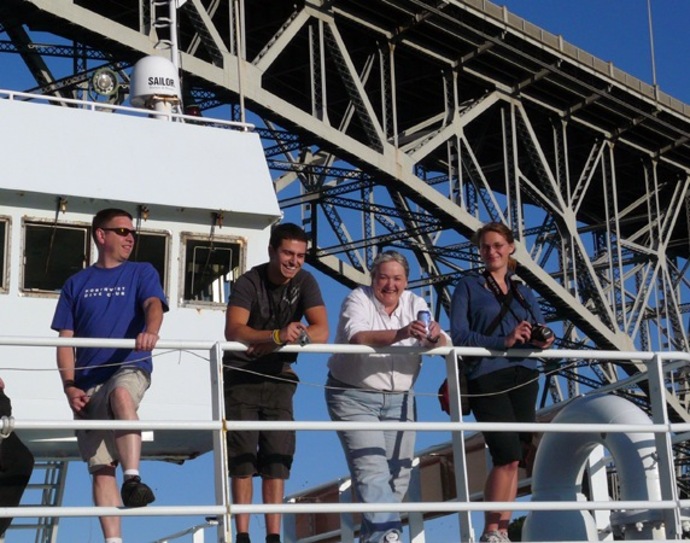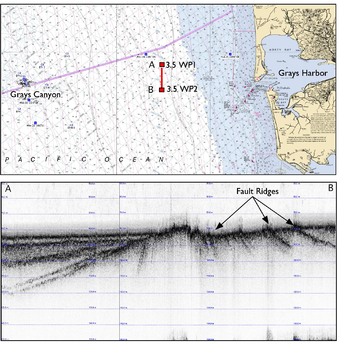Daily Report
On July 27th, very early in the morning, the Thompson rounded the J-buoy near the entrance to the Straits of Juan de Fuca and turned south for an ~ 80 nm transit to Grays Harbor, WA for transfer and pick up of a high definition camera to be used on Jason. The transit was completed under gray skies with fog, but relatively calm seas so the ship made good speed. Following completion of the transfer of gear in the afternoon, a 3.5 kHz sonar survey was completed of small, faulted ridges west of Grays Harbor during a transit for a follow-on Engineering Dive with Jason. Upon arrival on the site at ~ 2000, a CTD survey was conducted for a sound velocity profile of the ocean water with depth – information key to obtaining good vehicle navigation.
Through the late night and into the morning of July 28th, an ~ 12 hr calibration of the Ultra-short Baseline (USBL) system was completed and a new program for controlling the ship and Jason under dynamic positioning was tested. The USBL is a technology used for tracking the position of underwater vehicles. It includes a transceiver (a sensor that can both send and receive acoustic signals) that is mounted on a long pole over the side of the ship and a transponder on the ROV that responds to signals sent by the transceiver. During the cruise, this will allow us to navigate the vehicle with high accuracy – for example at 3000 feet beneath the oceans surface, the vehicle can be located in real-time within a circle of ~ 30-45 feet. This capability is critical to accurately “map out” the locations of cabled infrastructure and sensor locations. Dynamic positioning allows interaction between the Global Positioning System (GPS), the ships computers, and its station-keeping system (bow thrusters and z-drives). In ‘DP’ the ship is under “computer” control, allowing the ship to be held in a position within a couple meters of the target.
Impressions
Of the 35 people aboard in the science party, 11 are students and many of them are experiencing a research cruise for their first time. Below are first impressions of three of the undergraduate students aboard:
As an undergrad participating on my first research expedition I can safely say a feeling of being overwhelmed was my initial reaction once aboard the docked R/V Thomas G. Thompson. This feeling did not last too long as everything began to fall into place: our berths were issued, meetings got under way, and introductions were made around the room.
The introductions to the other scientist and crew really open your eyes to the sheer size and complexity of the operations taking place during these next 28 days. Not just the fact that there are people from all over the country, but the complex array of scientific disciplines is what I was truly amazed to discover. The specialties aboard the Thompson are too many to list, but what I can say is if you have a question related to almost anything you can think of, there is someone aboard who can help you or point you in the right direction. Also, many of the personnel onboard have fascinating stories of past expeditions such as the discovery of the Titanic and underwater volcanic eruptions that had never before been caught on film. As you start to find your place aboard the Thompson, the idea that you are part of this team and on the cutting edge of science really hits home in the best way possible.
The departure from the UW School of Oceanography dock was amazing. The ship easily and effortlessly pulled away and headed towards the locks. The route to the locks on this day was sunny without a cloud in the sky making it truly beautiful. Hundreds of other boaters were out, waving as they passed. Once Seattle came into view, I was stunned at the beauty of the city and the busy life that surrounds its streets and harbors.
Once we had departed, the other undergrads and I sat down and discussed our projects and bouncing ideas off one another really helped. Being aboard the Thompson is an education unlike that of any normal school classroom; here you are encouraged to derive your own research questions and methods, which is different than your typical undergraduate laboratory setting. Actually performing this task is much harder than you would think, in part because it takes a different kind of thinking to push the boundaries that have been previously established by others.
During the process of determining what project I am going to pursue during this research cruise, I learned that no one had before made a biological map of Hydrate Ridge and in particular the Southern Ridge. This project would allow me to answer many of the questions I have thought about such as the abundances of organisms and their spatial orientations to each other and to methane seeps.
It is only day three and I have learned so much and talked with so many experts in a multitude of scientific disciplines in such a short time that I can tell this will be an experience unlike any other in my undergraduate career.
(Derek Brady, UW Junior)
In just these first two days, I have found this cruise to be one of the most intellectually stimulating environments that I have ever been in. The people with whom I have spoken are excited about their work and willing to answer questions. As a geology student, I had a bit of apprehension because I have no training in oceanography. It has already become clear to me that there is no dividing line between oceanographers and geologists; most of the scientists on board were initially trained in geology. It is encouraging to me to be able to see this meld of two disciplines.
(Ann Bauer, UW Senior)
Looking back on today I am torn between telling you how bad life as an oceanographer is, or actually telling you the truth and risk there being a massive influx of new oceanographers competing with us for jobs in the future. Honestly, today was beautiful; the weather was warm with clear blue skies. The sound was full of boats, many slowing as they passed us, most of those waving at us like we were royalty – which from the third deck of the 274 ft R/V Thomas G. Thompson it did feel a lot like.
Initially, as an undergraduate student turning up on the ship, a hive of activity, everyone busy with their final preparations I felt daunted, with a feeling of being surplus to requirement, but that feeling passed with the day and eventually I felt like I was actually being useful. By the time I clambered up in to my bunk (hitting my head on the ceiling for the fourth time that day) I was exhausted, but content.
(Sam Monk, UW exchange student from Southampton, England)



